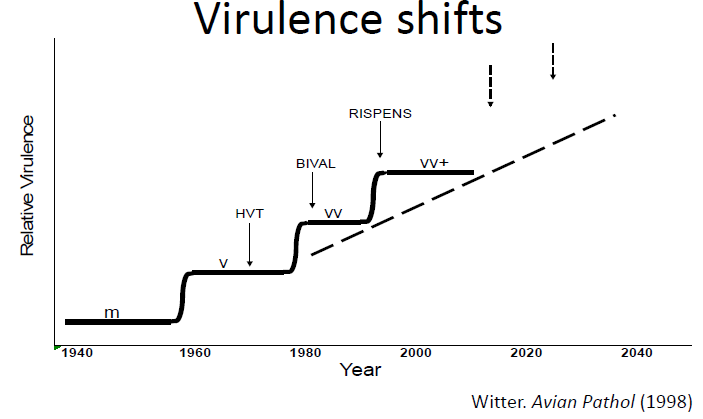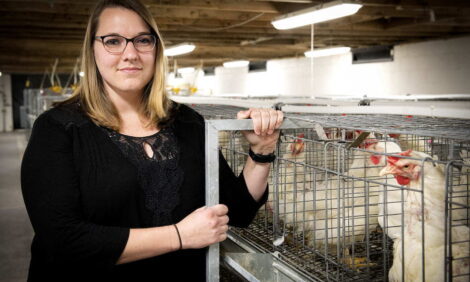



Halting the Evolution of Marek's Disease Towards More Virulent Forms
Marek's disease is an important affliction of poultry flocks worldwide, and can cause mortality rates of up to 100 per cent. At Merial's Global Avian Forum in Barcelona in April, John Dunn from the US Department of Agriculture's Avian Disease and Oncology Laboratory spoke about the evolution of the virus.Marek’s disease virus (MDV) is classified into three serotypes: serotype 1 (MDV-1) includes all pathogenic strains and their variants, serotype 2 (MDV-2) includes all naturally non-pathogenic chicken strains, and serotype 3 (MDV-3) includes turkey herpesvirus (HVT), which is also not pathogenic in chickens.
Pathotyping became an important classification of viruses not long after increased virulent forms of MDV were initially reported.
In a research paper, R.L. Witter first designated the virulence of MDV strains, or the severity of the damage they cause to animals, based on responses in vaccinated chickens and several years later included prototype isolates as a comparison against field viruses to better standardise the pathotype designations from other laboratories.
Witter recognised another increased virulence of MDV strains in the early 1990s in bivalent-vaccinated chickens, leading to four current MDV-1 pathotype designations: m (mild), v (virulent), vv (very virulent), and vv+ (very virulent plus).
Marek’s disease evolution
A major concern facing the poultry industry is the evolutionary trend of MDV towards repeated outbreaks of higher virulence.
The first wave of virus evolution from mild (mMDV) to virulent (vMDV) strains occurred during the 1950s and was likely due to the transformation of the industry into high-density poultry production.
The continuous availability of large populations of susceptible birds and failure to frequently clean poultry houses are certainly major factors in the evolution of MDV.
Subsequent evolution has been augmented by the periodical introduction of more efficacious Marek's disease vaccines. Because these vaccines fail to produce a sterilising immunity, where the pathogen would be wiped out in the bird, both vaccine and field viruses are able to replicate and shed within vaccinated hosts.
Characteristics of evolved Marek's disease virus
Designation of strains by pathotype is based on the ability to cause disease in birds vaccinated with HVT (turkey herpes virus) or HVT + SB-1 (turkey herpes virus and the SB-1 strain of the chicken herpes virus). These vaccines are used to protect against Marek's disease.
In addition to pathotyping response, past reports have demonstrated significantly higher replication for select vv+MDV strains compared to vMDV strains, as well as a prolonged phase of cytolytic infection for vv+MDV strains compared to vMDV strains.
The prolonged virus replication and presence of viral transcripts for the vv+MDV likely induces more severe damage and atrophy of lymphoid organs, which is commonly observed among vv+MDV strains.
Our group recently compared virus replication of 15 MDV strains, 5 from each virulent pathotype, and found a correlation between virus replication and virulence between vMDV and higher virulent strains, but in most cases there was no significant difference between vv and vv+MDV groups.
The bottom line may be that evolution is driven by the ability of replication.
Highly virulent MDV strains are also associated with severe lesions in the central nervous system and a variety of neurologic syndromes including transient paralysis, acute transient paralysis and persistent neurologic disease.
As opposed to classical transient paralysis in which birds totally recovered after a paralytic episode, acute transient paralysis is a fatal form of the symptom from which birds die in 48–72 hours. Persistent neurologic disease is characterised by the onset of nonparalytic clinical signs (ataxia, torticollis, and nervous tics) after recovery from paralysis.
Factors effecting Marek's disease virus evolution
Despite the unquestionable success of vaccination in control of MD, the vaccines themselves are believed to have contributed to virulence shifts.
Recent work has suggested that by keeping the host alive in formerly susceptible birds, vaccination prolongs the infectious period of virulent strains, allowing for the evolution of increased virulence.
Previous work has shown that dilution of vaccines, a common practice in US broiler production, can lead to reduced MD protection, reduced relative body weights, reduced vaccine DNA during the first 3 weeks, and increased MDV DNA load. Thus, it would be reasonable to presume that diluting vaccines can also have a direct effect on promoting virus evolution.
Future Marek's disease virus evolution
Until recently, it had been over 15 years since a comprehensive set of Marek’s disease virus (MDV) field strains had been solicited from poultry companies for pathotyping.
John Dunn and his colleagues pathotyped virus isolates from farms currently experiencing Marek’s disease outbreaks in the US, but found that virulence did not exceed previously archived isolates.
This suggests that current management and vaccine practices may have slowed the evolution of Marek’s disease virus.
Although the timing between vaccine introduction and virulence shift has exceeded previous cycles, the industry remains concerned about future evolutionary shifts.
Mr Dunn and colleagues recently developed a model for studying Marek’s disease virus evolution in a laboratory setting and to examine the influence of host genetics, specifically the major histocompatibility complex genes, which have a known influence on genetic resistance.
Not surprisingly, both host genetics and vaccination seemed to play a role in selecting for increased Marek’s disease virus virulence. Their results suggest that the progressive increase in virulence is partially masked as it circulates through vaccinated resistant genetic lines, but by applying this virus to less-resistant genetic lines, virus evolution can be clearly observed.
Controlling Marek’s disease by introducing new vaccines every time the virus evolves is not sustainable, thus it is critical that new strategies are explored for slowing virus evolution and improving efficacy of existing vaccines.











